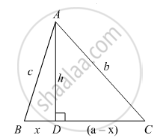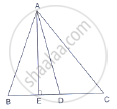Advertisements
Advertisements
Question
In the given figure, ∠B < 90° and segment AD ⊥ BC, show that
(i) b2 = h2 + a2 + x2 - 2ax
(ii) b2 = a2 + c2 - 2ax

Solution
(i) Since AD perpendicular to BC we obtained two right angled triangles, triangle ADB and triangle ADC.
We will use Pythagoras theorem in the right angled triangle ADC
AC2 = AD2 + DC2 ......(1)
Let us substitute AD = h, AC = b and DC = (a − x) in equation (1) we get,
b2 = h2 + (a − x)2
b2 = h2 + a2 − 2ax + x2
b2 = h2 + a2 + 𝑥2 − 2ax ......(2)
(ii) Let us use Pythagoras theorem in the right angled triangle ADB as shown below,
AB2 = AD2 + BD2 ......(3)
Let us substitute AB = c, AD = h and BD = x in equation (3) we get,
c2 = h2 + x2
Let us rewrite the equation (2) as below,
b2 = h2 + x2 + a2 - 2ax ......(4)
Now we will substitute h2 + x2 = c2 in equation (4) we get,
b2 = c2 + a2 - 2ax
Therefore, b2 = c2 + a2 - 2ax.
APPEARS IN
RELATED QUESTIONS
Construct a triangle ABC with sides BC = 7 cm, ∠B = 45° and ∠A = 105°. Then construct a triangle whose sides are `3/4` times the corresponding sides of ∆ABC.
A triangle has sides 5 cm, 12 cm and 13 cm. Find the length to one decimal place, of the perpendicular from the opposite vertex to the side whose length is 13 cm.
In a ΔABC, AB = BC = CA = 2a and AD ⊥ BC. Prove that
(i) AD = a`sqrt3`
(ii) Area (ΔABC) = `sqrt3` a2
In Figure, D is the mid-point of side BC and AE ⊥ BC. If BC = a, AC = b, AB = c, ED
= x, AD = p and AE = h, prove that:
(i) `b^2 = p^2 + ax + a^2/4`
(ii) `c^2 = p^2 - ax + a^2/4`
(iii) `b^2 + c^2 = 2p^2 + a^2/2`

In a quadrilateral ABCD, ∠B = 90°, AD2 = AB2 + BC2 + CD2, prove that ∠ACD = 90°.
∆ABD is a right triangle right-angled at A and AC ⊥ BD. Show that
(i) AB2 = BC x BD
(ii) AC2 = BC x DC
(iii) AD2 = BD x CD
(iv) `"AB"^2/"AC"^2="BD"/"DC"`
Determine whether the triangle having sides (a − 1) cm, 2`sqrta` cm and (a + 1) cm is a right-angled
triangle.
In an equilateral triangle with side a, prove that area = `sqrt3/4` 𝑎2
The co-ordinates of the points A, B and C are (6, 3), (−3, 5) and (4, −2) respectively. P(x, y) is any point in the plane. Show that \[\frac{ar\left( ∆ PBC \right)}{ar\left( ∆ ABC \right)} = \left| \frac{x + y - 2}{7} \right|\]
Find the altitude of an equilateral triangle of side 8 cm.
